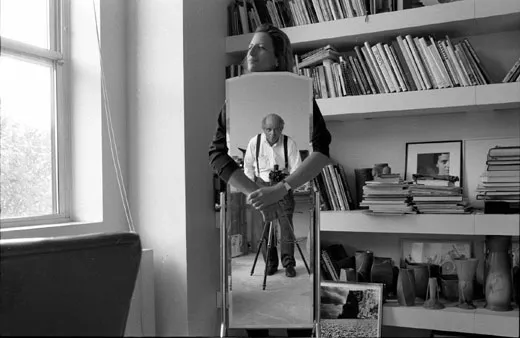Gaga Over a Gargoyle
From Margaret Bourke-White to Annie Leibovitz, photographers have scaled dizzying heights to frame the perfect prop
/https://tf-cmsv2-smithsonianmag-media.s3.amazonaws.com/filer/indelible-feb08-631.jpg)
The 61st-floor terrace of the Chrysler Building in Manhattan had rarely seen such a large crowd. There was photographer Annie Leibovitz and her assistant Robert Bean, standing on one of the eight gargoyles that grace the building's exterior. Dancer David Parsons was on another of the gargoyles, posing for Leibovitz. A video crew was on hand to record the proceedings. So was a writer and photographer from the New York Times. Hovering over them all was the spirit of Margaret Bourke-White (1904-1971), the swashbuckling Life photographer who had herself been photographed atop one of the Chrysler's gargoyles in 1934.
"The height wasn't terribly bothersome," says John Loengard, the photographer on assignment for the Times that day in August 1991. Rather, he had only one thought: "This was all...very scary-looking, but was it going to be an interesting picture?"
As Leibovitz snapped away at Parsons, Loengard snapped away at Leibovitz—and answered his own question in the affirmative. The resulting picture appeared in the Times' Arts & Leisure section on September 8, 1991, where it did nothing to diminish Leibovitz's already outsize reputation. The accompanying article, by Bourke-White biographer Vicki Goldberg, noted that the "only time [Leibovitz] lets someone hold her is when she puts one foot way out on the gargoyle's head, and once she feels secure there she makes her assistant let go and stands free above the New York skyline with the wind whipping at her trousers."
By 1991, Leibovitz had already made some of her most arresting portraits—John Lennon (naked) and Yoko Ono (clothed) just hours before he was killed, Bette Midler lounging among the roses, Demi Moore large with child. Leibovitz's work had just been featured at the Smithsonian's National Portrait Gallery in Washington, D.C. in the first mid-career retrospective the museum had ever conferred upon a photographer. (Her most recent show, "Annie Leibovitz: A Photographer's Life, 1990-2005," travels to San Francisco's Fine Arts Museum in March.) She had been invited to give a lecture at the Rochester Institute of Technology, which had sent the video crew. And for the Times story, the paper had assigned not only Goldberg but also Loengard, a distinguished former Life photographer and picture editor who had edited both Bourke-White's and Leibovitz's work.
Leibovitz had started the day shooting Parsons, the founder and artistic director of the dance company bearing his name, in her downtown studio, but as evening approached she moved the shoot to the Chrysler Building. "I can't help but feel that we'll have Margaret Bourke-White's shadow over us," she can be heard saying on the video. (She declined to be interviewed for this article.) "But that's nice; that's really, really nice." Darien Davis, an aide to Leibovitz at the time, says, "I think that we sort of took the building by surprise. She just asked the office people, and they allowed access." (A representative of the Chrysler Building notes that today this would be "much more the exception than the rule.")
Parsons was game; he and Leibovitz had talked the gargoyle idea over a few days beforehand, he says. He estimates that he spent a total of about 45 minutes out on it, and he is matter-of-fact about the anxiety attack he had around the 25-minute mark. "The danger of having an anxiety attack is that you get dizzy," he says, "and I really needed to just get control again."
Leibovitz and Parsons began a pas de deux, she shooting and shouting encouragement, he standing on—and draping himself over—the stainless-steel ornament, nearly 700 feet over Midtown Manhattan, as Loengard positioned himself on the terrace. "I wondered if any photograph could justify the risks they were taking," he would recall later. In the back of his mind were two photographers who had fallen to their deaths in pursuit of the right vantage: James Burke in 1964 in the Himalayas, and Ethan Hoffman in 1990 in Newark, New Jersey. But Leibovitz, he recalls, seemed perfectly at ease. "Still photographers always put their pictures above everything else," he says. "They can take an inadvertent step backward and fall off a loading dock."
Then, as dusk was falling, Loengard saw his moment: Leibovitz exchanging film with her assistant Robert Bean. "For a split second, everybody's gesture was clear," Loengard says, "and all you can do is hope that that's what you got." That, indeed, is what he got.
David J. Marcou is a writer and photographer in La Crosse, Wisconsin.
